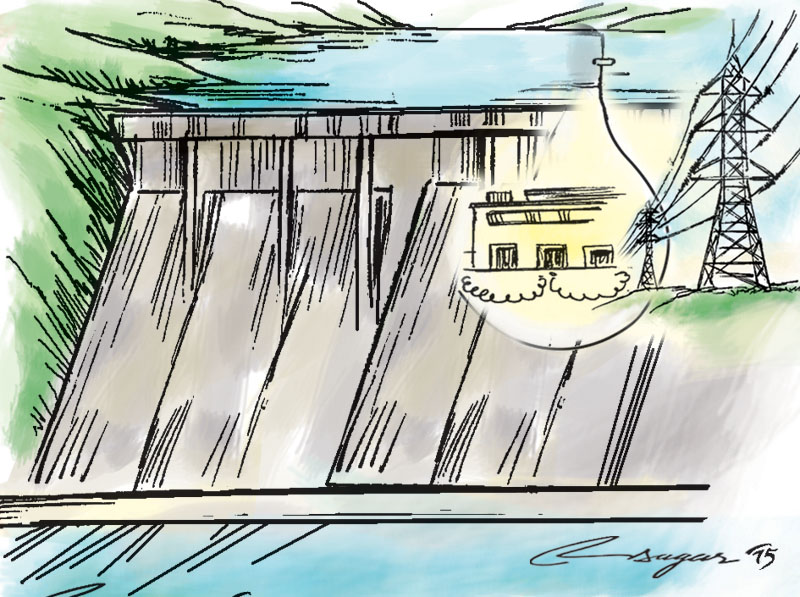Inclusive growth: Ambitious but achievable
This inclusive growth approach will improve the quality and efficiency of public and private services in Nepal. Inclusive growth is making sure that every Nepali citizen is included in equitable growth for the greatness of our progress
As long as we have poverty it is very difficult for us to be an independent country. We will eliminate extreme poverty (below USD 1.9 per day) by 2020 and we want to be a developed nation by 2040. Our goal is to enhance our GDP from the present around USD 20 Billion to USD 1 Trillion in present value terms, by 2040. This time-bound goal is ambitious but achievable.
Normally it seems that the government of Nepal has no intention to develop big projects using its own funds. It would remain the facilitator in the execution of the project. That is why we are expecting to generate around 327 MW of electricity in this FY 2015/16 winter. Our suppressed peck electricity demand currently is around 1,500 MW. At the same time our petroleum imports bill is increasing every year due to growing demand for fuel to power generators and LPG to cook food. As per Nepal Rastra Bank during FY 2013/14 we imported petroleum products worth Rs 133 Billion. Our estimation is, we can easily reduce the importing volume by half, if we have required electricity generation in Nepal. We are facing humanitarian disaster due to blocked supply routes in the south.
This situation must not be allowed to continue. Our bottlenecks for economic growth are load-shedding (energy) and low quality transportation networks.
We have to use our existing resources in a specific, measurable, achievable, realistic and time bound way that will drive Nepal to a fully developed country. The following model will transform Nepal from a least developed country status today to a developed nation by 2040.
The outcome of micro finance has been remarkable. Micro finance institutions have moved capital closer to the poor people making it available virtually to everyone who needs it. As at July 16, 2015 total fund disbursement from micro finance firms from the beginning is around Rs 272 Billion and loan repayment is Rs 217 Billion. Borrowers can easily repay because their return on investment is very high since they have very low administrative cost, high turnover and normally no tax.
Our efforts must be directed to solve our bottlenecks for economic growth, which are load-shedding (energy) and low quality transportation networks. In order to tackle power cuts during the dry season, we have to start medium size reservoir projects such as the 1,200 MW Budhi Gandaki Hydroelectric Project (BGHP). BGHP is at about a distance of 80 km from Kathmandu on the Prithivi highway (Kathmandu-Pokhara). The total project cost is estimated at Rs 250 Billion, including around Rs 50 billion for land acquisition and resettlement of the affected people.
There after we can start constructing dams in Tamor in the east, Kaligandaki in the western region and Nyasalgad in the far west region. This creates three additional reservoirs to generate hydroelectric power. Water that is stored in a reservoir can provide a steady, predictable amount of electricity that is inexpensive and does not produce emissions like coal, petrol, diesel, and gas do.
Simultaneously we can start construction of high speed electric rails (HSR) and cable car systems, connecting various cities to the hilly and Himalayan region to the market centers and tourist attractions, including various lakes that will be created by our dams. Why HSR projects? Because to construct one kilometer of HSR (two lines) 3.2 hectares is required, whereas, 9.3 hectares land is required to construct one kilometer of a six-lane highway. In Nepal land acquisition is a burdensome job. The concept of “supply creates its own demand” is applicable in our case. There is scope of exponential increase in the supply of electric power. There is also a very high scope for exponential increase in the demand for electric power.
Initially we have to plan HSR project only on high demand routes such as Kathmandu valley metro system and Kathmandu-Chitwan HSR.
We can also start additional three reservoir type hydropower projects (Tamor, Kaligandaki, and Nyasalgad) simultaneously by converting them into limited company and issuing bonds for 30 per cent equity. We will be creating additional three lakes by these hydro dams. We can start four further additional cascade hydropower station from the above said total four reservoir based electricity projects similar to Devighat hydropower station which is the cascade hydropower of Trishuli power station. Supply creates its own demand.
We must give minimum 11.6. per cent growth rate per annum target in our GDP to our nation’s Chief Executive Officer (Prime Minister). Why 11.6 per cent? Our population growth rate is estimated at 1.6 per annum in 2015. So, we need 1.6 percent annual rate of GDP growth to take care of the population increase.
Another five per cent growth rate is required to provide increased standard of living to the people, and another 5 per cent is needed to provide increased momentum in the subsequent years. It makes no sense to continue hiring our nation’s CEO without giving him or her a realistic target to achieve.
This inclusive growth approach will improve the quality and efficiency of public and private services in Nepal. Inclusive growth is making sure that every Nepali citizen is included in equitable growth for the greatness of our progress.
Pant is CEO of Nirdhan Utthan Bank






